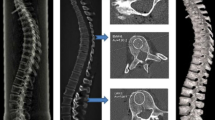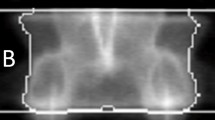Abstract
An experiment was performed to determine the relative contribution of the cortical shell and of the central trabecular bone to the peak, non-destructive compressive strength of excised human lumbar vertebrae. The vertebral “units” tested utilized the adjacent intervertebral discs to distribute the loads. Among other results the study indicated that (1) the cortex generally contributes 45–75% of the peak strength, regardless of percent ash or physical density of the trabecular bone; (2) when the ash content of a vertebral trabecular bone is <59%, only 40% or less of the forces are transmitted directly by the central trabecular bone. When the ash content exceeds 59, >40% of the forces are transmitted via the central trabeculae and, as would be expected, (3) less force is transmitted by way of the central trabeculae in older subjects than in those ≦40 years of age.
Résumé
Un travail expérimental a été entrepris pour déterminer la contribution relative de la couche corticale et de l'os trabéculaire central envers une force compressive, non-destructive exercée par une vertèbre lombaire humaine excisée. Les ≪unités≫ vertébrales testées transmettent les charges par l'intermédiaire du disque intervertébral adjacent. L'os cortical amortit généralement de 45 à 75% de la force exercée, quel que soit le pourcentage de cendre ou la densité physique de l'os trabéculaire. Lorsque le contenu en cendre de l'os trabéculaire vertébral est inférieur à 59%, seuls 40% des forces ou un pourcentage même inférieur sont transmis diectement par l'os trabéculaire central. Lorsque le contenu en cendres dépasse 59%, moins de 40% des forces sont transmises par les travées osseuses centrales et, ainsi qu'on peut le prévoir, une force moins grande est transmise par les travées centrales de sujets âgés. Elle est plus élevée chez des sujets de 40 ans ou d'âges inférieurs.
Zusammenfassung
Es wurde ein Experiment durchgeführt, um den relativen Beitrag der Cortex und des zentralen trabeculären Knochens festzustellen, wenn excidierte menschliche Lumbalwirbel einem maximalen, nicht destruktiven Kompressionsdruck ausgesetzt werden. Die geprüften vertebralen „Einheiten” benützen die nächstliegende Bandscheibe, um die Last zu verteilen. Unter anderem zeigten die Resultate, daß: I. der Cortex im allgemeinen zu 45–75% des maximalen Druckes beiträgt, ungeachtet des prozentuellen Anteiles an Asche oder der physikalischen Dichte des trabeculären Knochens: 2. wenn der Aschegehalt eines trabeculären Wirbelknochens kleiner als 59% ist, so werden nur 40% oder weniger der Last direkt durch den zentralen trabeculären Knochen übermittelt. Übersteigt der Aschegehalt 59%, so werden mehr als 40% des Druckes durch die zentralen Trabekel übertragen, und, wie zu vermuten war 3. wird bei älteren Individuen weniger Druck durch die zentralen Trabekel vermittelt, als bei den weniger als 40jährigen.
Similar content being viewed by others
References
Arnold, J. S.: Quantitation of mineralization of bone as an organ and tissue in osteoporosis. Clin. Orthop.17, 167–175 (1960).
Atkinson, P. J.: Variation in trabecular structure of vertebrae with age. Calc. Tiss. Res.1, 24–32 (1967).
Bartley, M. H., Jr., J. S. Arnold, R. K. Haslam, andW. S. S. Lee: The relationship of bone strength and bone quantity in health, disease and aging. J. Geront.21, 517–521 (1966).
Bell, G. H., O. Dunbar, J. S. Beck, andA. Gibb: Variations in strength of vertebrae with age and their relation to osteoporosis. Calc. Tiss. Res.1, 75–86 (1967).
Bromley, R. G., N. L. Dockum, J. S. Arnold, andW. S. S. Jee: Quantitative histological study of human lumbar vertebræ. J. Geront.21, 537–543 (1966).
Brown, T., R. J. Hansen, andA. J. Yorra: Some mechanical tests on the lumbrosacral spine with particular reference to the intervertebral discs. A preliminary report. J. Bone Jt Surg. A39, 1135–1164 (1957).
Chalmers, J., andJ. K. Weaver: Cancellous bone: Its strength and changes with aging and an evaluation of some methods for measuring its mineral content. I. Age changes in cancellous bone. J. Bone Jt Surg. A48, 289–298 (1966).
Dunnhill, M. S., J. A. Anderson, andR. Whitehead: Quantitative histological studies on age changes in bone. J. Path. Bact.94, 275–291 (1967).
Eie, N.: Load capacity of the low back. J. Oslo Cy Hosp.16, 73–98 (1966).
Evans, F. G.: Stress and strain in bones. Springfield, Ill.: Ch. C. Thomas 1957.
Perey, O.: Fracture of the vertebral end-plate in the lumbar spine: An experimental biomechanical investigation. Acta orthop. scand. (Stockh.), Suppl.,25 (1957).
Russ, S.: Brief acceleration: Less than one second. Chap. VI-C in: German aviation medicine: World war II, p. 584–597. Washington, D. C.: U. S. Gov't. Printing Office 1950.
Author information
Authors and Affiliations
Additional information
From the Department of Radiology, Yale University School of Medicine (S.D.R. and E.S.) and the Department of Engineering and Applied Science, Yale University (J.B.). Supported by USPHS Grants AM-09664 and GM-01152
Rights and permissions
About this article
Cite this article
Rockoff, S.D., Sweet, E. & Bleustein, J. The relative contribution of trabecular and cortical bone to the strength of human lumbar vertebrae. Calc. Tis Res. 3, 163–175 (1969). https://doi.org/10.1007/BF02058659
Received:
Issue Date:
DOI: https://doi.org/10.1007/BF02058659




